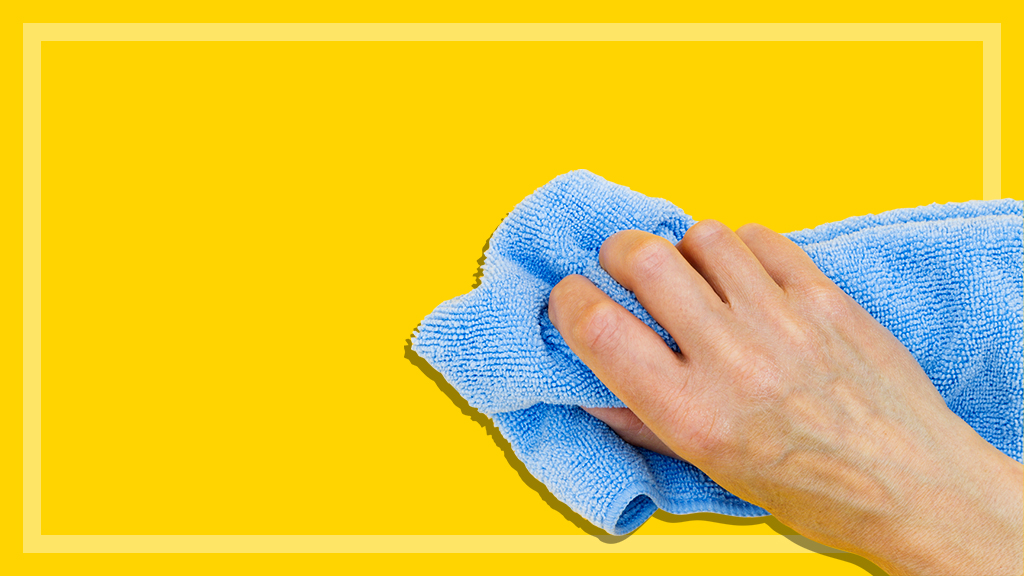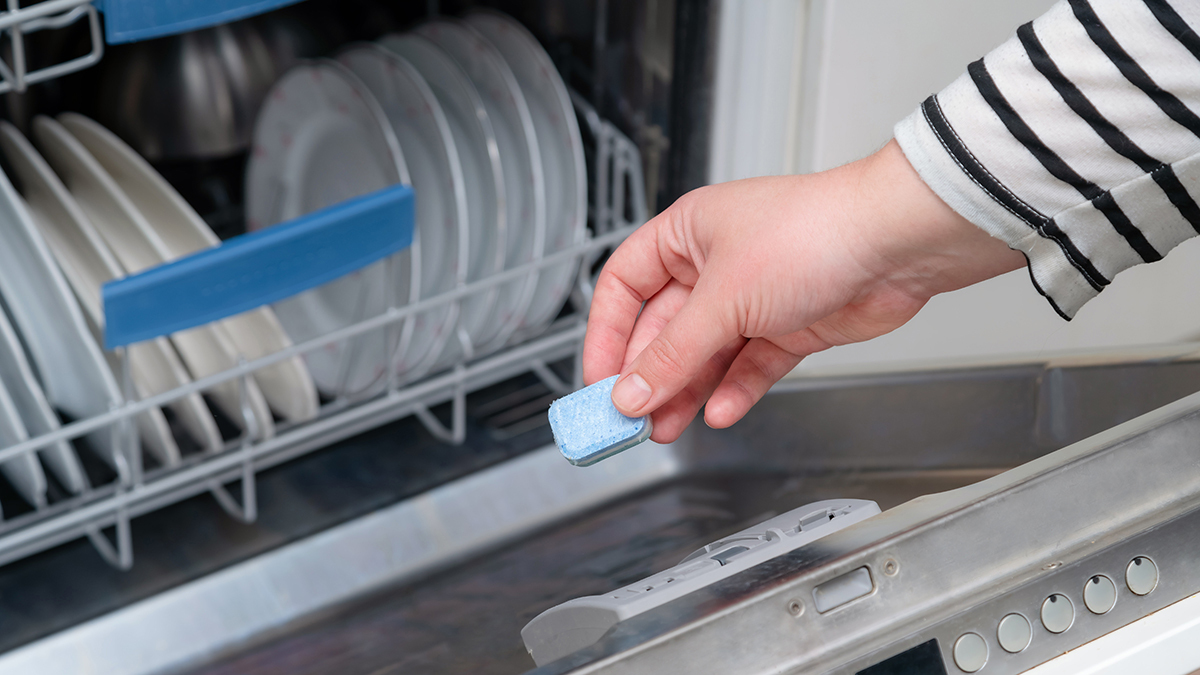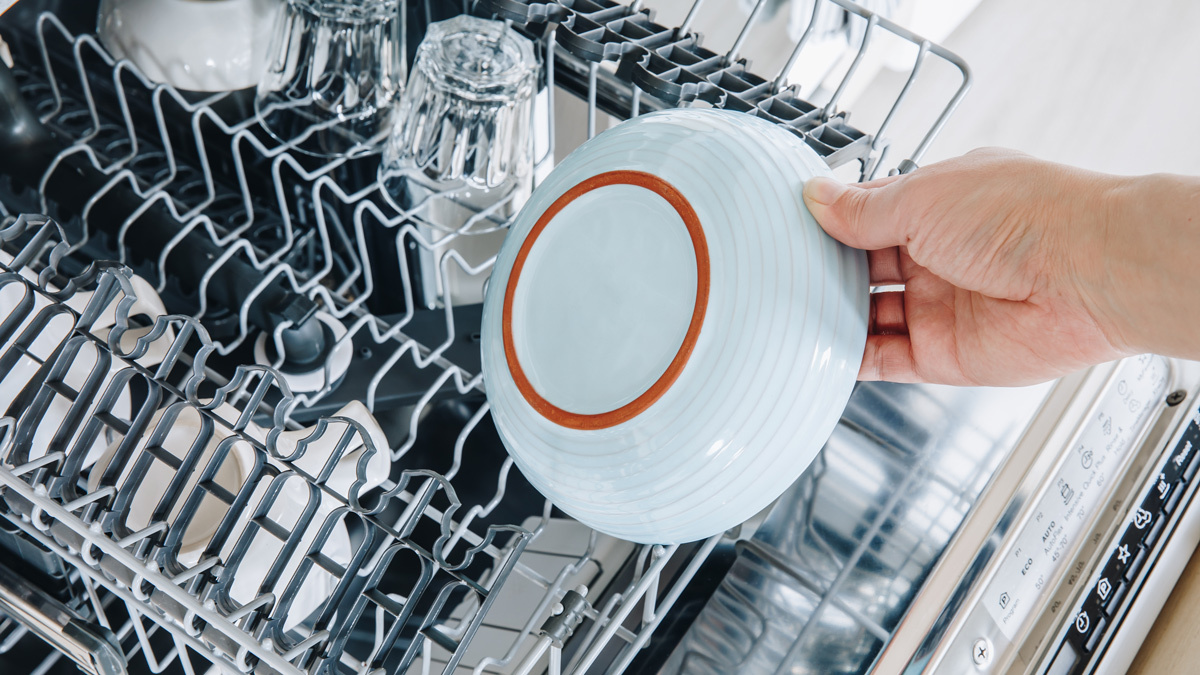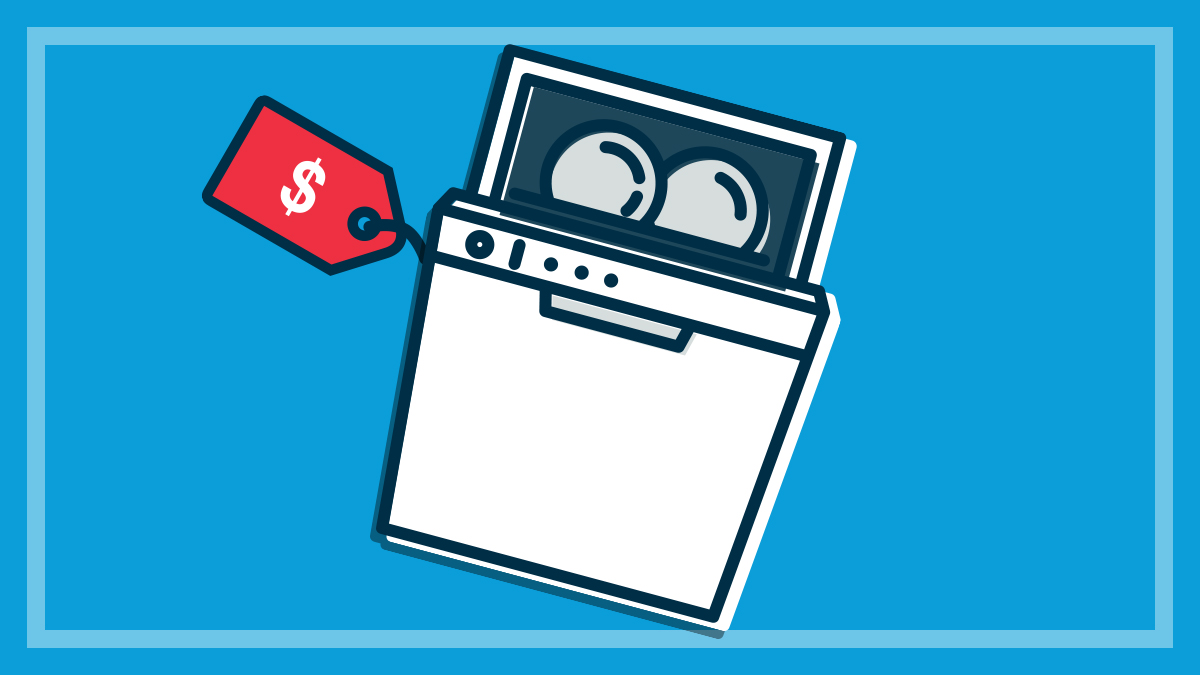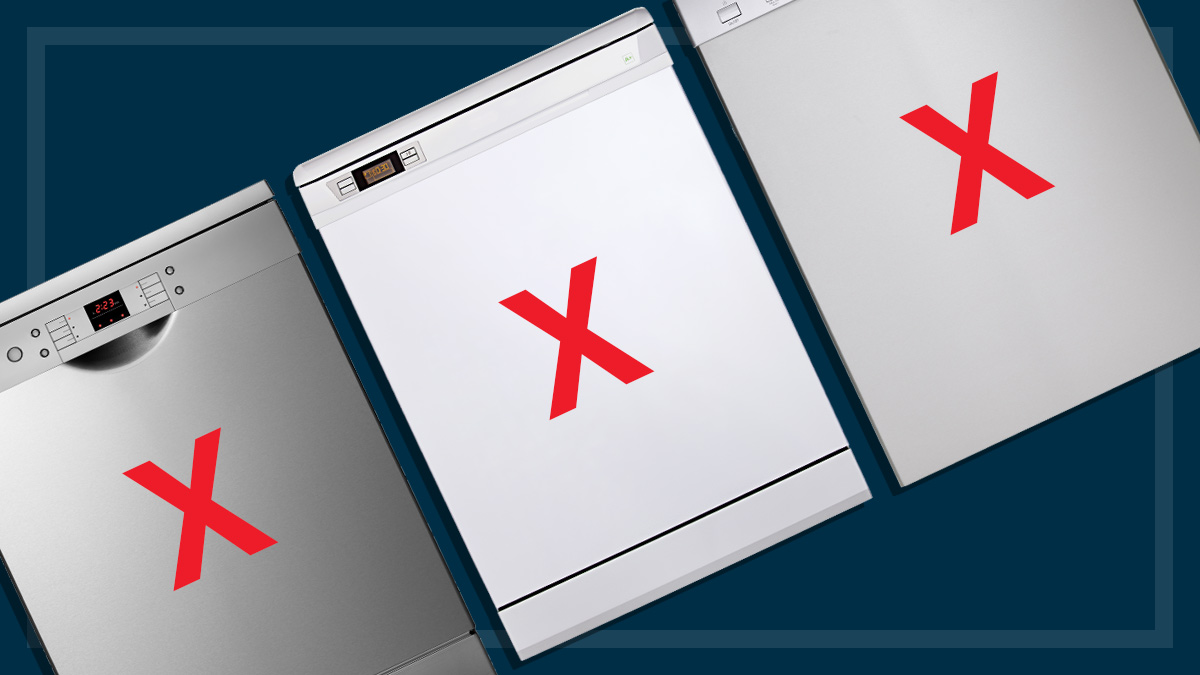Get our independent lab tests, expert reviews and honest advice.
How to clean your dishwasher
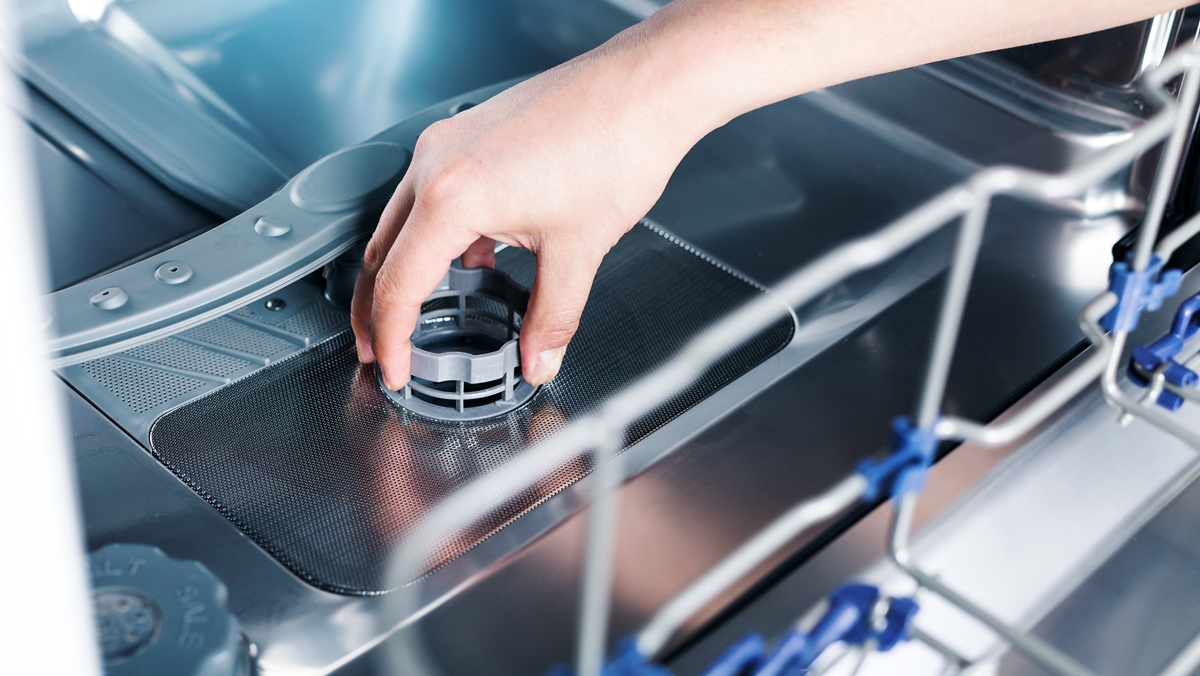
We expect our dishwasher to last for more than 10 years, but if you don’t take the time for a few minutes of maintenance then yours may not go the distance.
On this page:
- What should you use to clean your dishwasher?
- Maintenance tasks to keep your dishwasher happy
- How to clean a clogged dishwasher filter
- How to clean a smelly dishwasher
- How to clean the spray arms on a dishwasher
- How to clean a mouldy dishwasher
- What to do if you've got hard water
You might dread doing it, but a little dishwasher TLC actually isn’t too onerous.
From removing odours and mould to general maintenance, here are our best tips to help you keep your dishwasher running trouble-free.
(Can’t stand the thought of dishwasher maintenance and just want to buy a new one? Check our reviews to find the best dishwasher for your needs and budget.)
What should you use to clean your dishwasher?
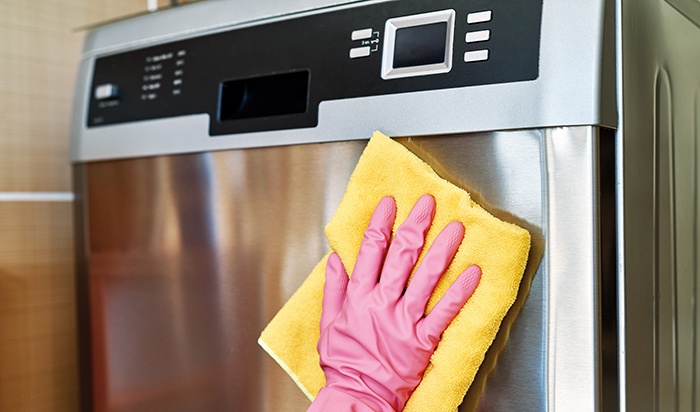
You should use a soft, damp cloth or kitchen sponge to clean your dishwasher, and a plastic scrubbing brush and toothbrush to shift stubborn mould stains.
Never use a metal scourer or steel wool as these can damage the surfaces.
How to clean the outside of your dishwasher
You can clean your dishwasher’s exterior with a soft cloth and hot soapy water, paying attention to corners, handles and around the controls.
(If you want to use a multipurpose cleaner, check your manual first.)
Glass cleaner works wonders on grime and fingerprints on stainless steel. For fully integrated appliances, clean the fascia as you would the rest of your cabinetry.
Glass cleaner works wonders on grime and fingerprints on stainless steel
Your door seals should also get a wipe down with a soft damp cloth – this helps keep mould and foul odours at bay, and clears away any obstructions that could prevent the door from sealing properly.
How to clean the inside of your dishwasher
There are various cleaning agents suitable for use inside your dishwasher, including vinegar, bicarb soda, bleach, citric acid or a variety of purpose-made commercial dishwasher cleaners.
Running a cleaner through your dishwasher is a great way to flush away built-up grease and limescale, but unless you’re dealing with a decade’s worth of grime in one go, you could be better off with plain old white vinegar.
Safety warning: If you’re using harsh chemicals, wear gloves and make sure your kitchen is well ventilated.
Pros and cons of using vinegar
Like its commercial counterparts, vinegar helps shift discolourations, foul smells and nasties that have built up in your pipes. But it has the added benefits of being less toxic, plus it’s cheaper and readily available.
But before you pull out the vinegar, check your manual.
Some dishwasher manufacturers, such as Miele, advise against using vinegar in their appliances as its acidity can potentially damage sensitive internal components.
How to clean your dishwasher with vinegar
- Pour two cups of vinegar into a bowl and place it in a rack in your otherwise-empty dishwasher.
- Give it a run, pausing the cycle in the middle for half an hour or so to give it an extra good soaking.
- If the dishwasher still gives olfactory offence, throw in a generous handful of baking soda and run it again to give stubborn smells their marching orders.
Why pour the vinegar into a bowl and not just tip it straight in? Because many dishwashers run their drain pump at the start of the cycle to clear residual water, and this would wash your vinegar straight down the drain.
Using a bowl keeps the vinegar in the machine where it’s needed.
Maintenance tasks to keep your dishwasher happy
Staying on top of smaller maintenance tasks is well worth the effort: you’ll get better results from your dishwasher, and it can save you from bigger (and expensive) problems down the track.
Here are the regular jobs that’ll keep your dishwasher running smoothly.
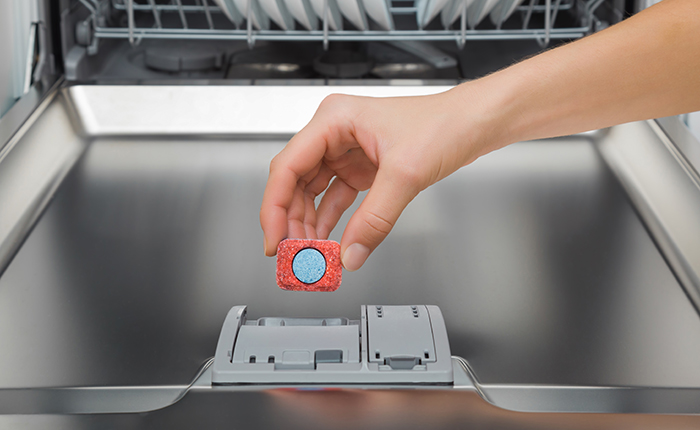
Daily
1. Scrape and go
There’s actually no need to rinse plates before racking them – and rinsing can even fool your dishwasher into thinking your crockery’s cleaner than it is, so it won’t wash as well.
2. Pick the best detergent
Not only will it do a better job, a quality cleaner is less likely to leave detergent residue behind and will help prevent slimy deposits from building up in your appliance.
3. Leave the door ajar
This isn’t always practical, but it helps extend the life of your door seals, and circulating air helps keep mould and odours at bay.
Weekly
1. Clean the filter
A filter full of food scraps and grease will be the source of most dishwasher problems, so cleaning the filter is essential for keeping your machine healthy.
2. Clean your dishwasher seals
Built-up grime around the seals can cause them to deteriorate more quickly. Run a damp cloth over door seals and contact points to keep them in top condition.
Monthly
1. Give the exterior a once-over
This not only keeps your kitchen looking spick and span, it helps keep corrosion at bay.
2. Fill the rinse aid dispenser
Topping up the reservoir next to the detergent dispenser will help keep your glasses streak-free. Many dishwasher tablets include their own rinse aid, but it’s extra important if you use a powder detergent.
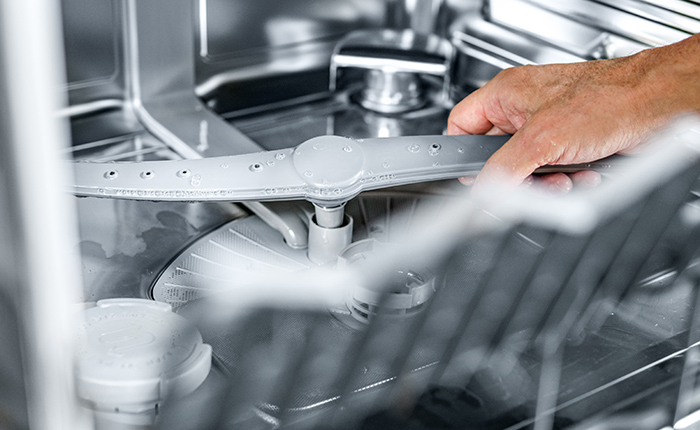
Yearly
1. Check the spray arms
Clearing any blockages can restore lost performance.
2. Wash on hot
Run the dishwasher on its hottest cycle while empty. Or better yet, add a bowl of vinegar or a commercial cleaner. This helps flush grease, limescale and deposits out of the pipes and removes foul odours.
How to clean a clogged dishwasher filter
If your dishwasher’s not draining properly, there’s a good chance it’s because the filter is blocked.
Even if it’s not, cleaning the filter is an important (if icky) part of your dishwasher routine, as grease and food scraps can collect in it, causing blockages, bad smells and other hygiene issues.
Modern dishwashers are designed for easy filter removal and cleaning, so there’s really no excuse for putting it off any longer.
Here’s what to do:
- Empty the dishwasher and remove the bottom basket.
- Remove the filter: it’ll be in the lowest part of the dishwasher and should twist out without the need for tools.
- Wash out the internal filter under hot running water, lightly scrubbing with a plastic brush to remove the grease and grime.
- Rinse the bigger trap filter under hot water.
- To replace the filter, simply reverse the removal process.
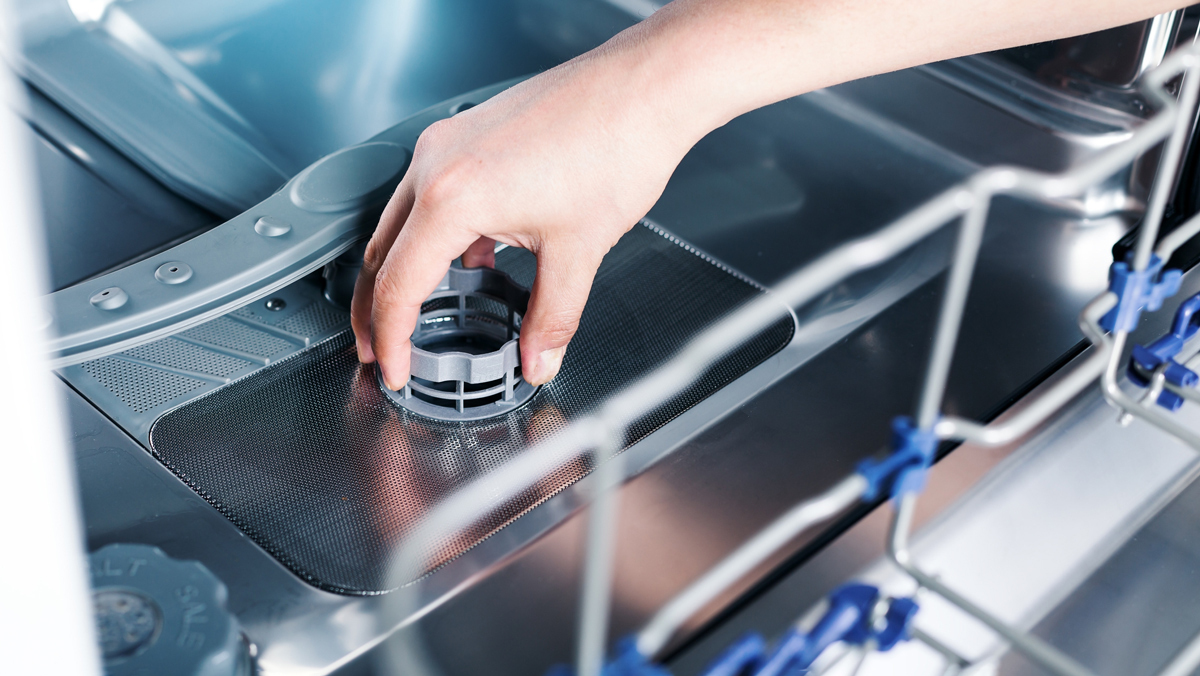
How to clean a smelly dishwasher
A dishwasher that’s on the nose isn’t just unpleasant, it can be a sign of mould or harmful bacteria building up in its murky depths.
It could also be a sign of grease and food particles lurking in the bottom of the machine.
A dishwasher that’s on the nose can be a sign of mould or harmful bacteria building up in its murky depths
If your dishwasher’s been sitting for a while with dirty plates in it, then there’s a good chance that’s the source of the stench and all you need to do is actually run it.
Normally we recommend only running your dishwasher when it’s full, but if it’s getting whiffy then you might want to make an exception.
If the bad smells don’t disappear after running a cycle, you’ll need to take steps to actively combat them.
- First, remove the racks – these will only get in your way, and it’s a good opportunity to give them a good scrub in the sink with hot soapy water.
- Next up, clean the filter. Grease and food particles can build up rapidly in your filter, and it’s the part of your dishwasher most likely to be responsible for strange odours.
- Now sprinkle a cup of baking soda into the bottom of the tub and let it sit overnight. (Baking soda is famous for absorbing nasty odours.)
- Run a hot cycle the next morning and the baking soda should have removed any remaining smells.
Dishwasher still smelly? Here’s what to do next:
Water pooling in the bottom of your dishwasher is a sign that the drain hose may need some attention.
Check the drain hose for obstructions – blockages or restrictions can cause dirty water to pool instead of draining away, which could be the source of offensive smells.
You may need to remove your dishwasher from your cabinetry and detach the drain hose from the drain under the sink to access it.
If you can fully remove your drain hose from your dishwasher it should be easy to see any blockages, which you can clear with the garden hose or a long thin stick.
Read more: Experiencing specific problems with your dishwasher? Our dishwasher troubleshooting guide can help.
How to clean the spray arms on a dishwasher
If your dishwasher’s not cleaning as well as it used to, a blocked spray arm could be the culprit.
Over time, grime can become lodged inside the jets (particularly if you don’t clean your filter regularly), making them less effective. Giving them a clean can improve your dishwasher’s functioning.
Here’s how to do it:
- Remove the spray arms.
- Poke a toothpick or other soft, pointy object into the water exit holes to clear any obstructions.
- Reinstall the spray arms.
Note: Don’t use sharp metal objects to clear the spray arms as it can damage them.
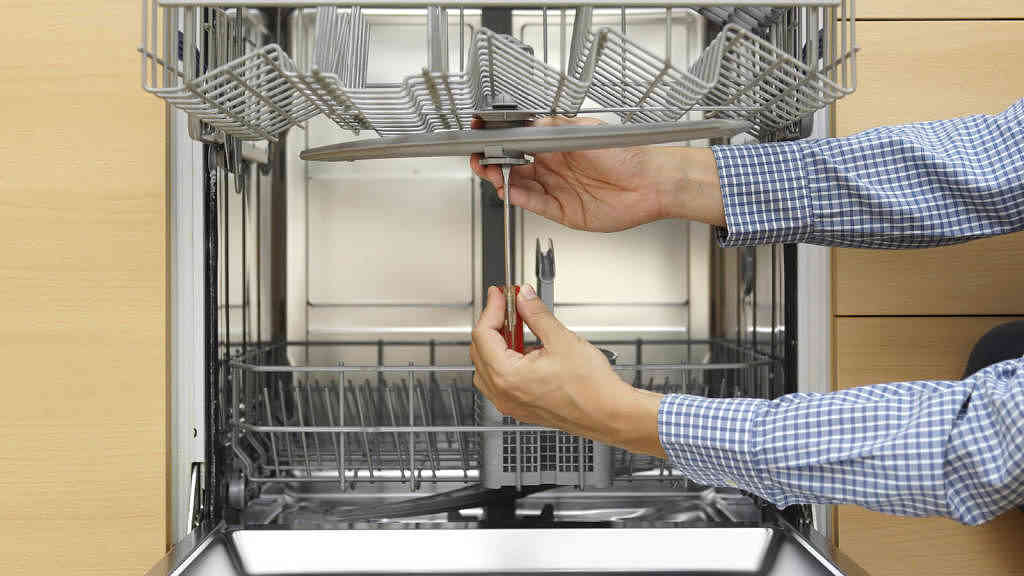
How to clean a mouldy dishwasher
A mouldy dishwasher isn’t just gross, it can be seriously bad for your health.
While visible black spots or a musty odour coming from your dishwasher are clear signs of a mould problem, you may have mould issues and not even realise.
It’s best to assume that there’s mould lurking somewhere in your dishwasher, even if you can’t see it
Many types of mould are tiny, colourless and odourless, so it’s best to assume that there’s mould lurking somewhere in your dishwasher, even if you can’t see it.
Because mould spores float around in the air, no home will ever be truly mould-free and the hot, moist insides of your dishwasher are the ideal environment for mould to grow.
How to combat mould in your dishwasher
- Remove the racks and wash them in hot soapy water.
- Wipe down the interior and around the door seal with a soapy sponge or washcloth.
- Refit the racks and let everything air dry thoroughly.
- Use vinegar to kill the mould: fill a dishwasher-safe container with a cup or two of vinegar and pop it in the rack with the lid off.
- Run a hot cycle with the dishwasher empty (except for your container of vinegar).
- Sprinkle a cup of baking soda into the dishwasher cabinet and run a second hot cycle.
- Scrub any remaining mould with a toothbrush and soapy water, paying particular attention to sharp corners and around the door seal.
How to get rid of mould using bleach
If vinegar’s not cutting the mustard, then you can bring out the heavy hitter: chlorine bleach, a highly effective mould killer, which also removes mildew stains as an added bonus.
Bleach is powerful stuff, so don’t pour it directly onto rubber seals; remember to wear gloves; and make sure your kitchen is well ventilated.
Safety warning: You should never mix bleach with other chemicals, including vinegar, as it can create toxic gas.
To de-mould your dishwasher with bleach, remove the dishwasher racks, then dilute 250mL of bleach in 4L of water and scrub your dishwasher’s insides with a stiff plastic brush. (Don’t use a wire brush as it can damage your appliance.)
Then, use an old toothbrush to get into any sharp corners or behind the door seal. (Note that it may not kill mould that’s penetrated deep into the porous surfaces of your seals.)
Next, run an empty cycle to rinse out any residual bleach.
Leave the door slightly ajar between cycles to allow air to circulate, which can help reduce the likelihood of mould returning.
What to do if you’ve got hard water
Some regions in Australia have hard water, which is water with a high concentration of minerals such as calcium and magnesium. It makes dishwasher detergent less effective, can cause hazy clouding on glassware over time, and can even damage the dishwasher itself.
Generally, water in Australia is relatively soft, but mineral concentrations do vary from region to region.
If your home has hard water you should:
- increase the amount of detergent you use
- use rinse aid to boost washing performance
- run a cleaner/descaler thorough your dishwasher regularly, or whenever you notice a build-up of limescale deposits (the simplest options are vinegar or citric acid, or you can use a commercial product).
You should also take preventative measures to reduce the impact of hard water on your dishwasher. The simplest solution, aside from regular descaling, is to switch to a detergent with a water softener.
A more permanent solution is to install a water softener in your home. Water softeners can demineralise and soften hard water, which is good for your washing machine, sinks, showers and sprinklers as well as your dishwasher.

